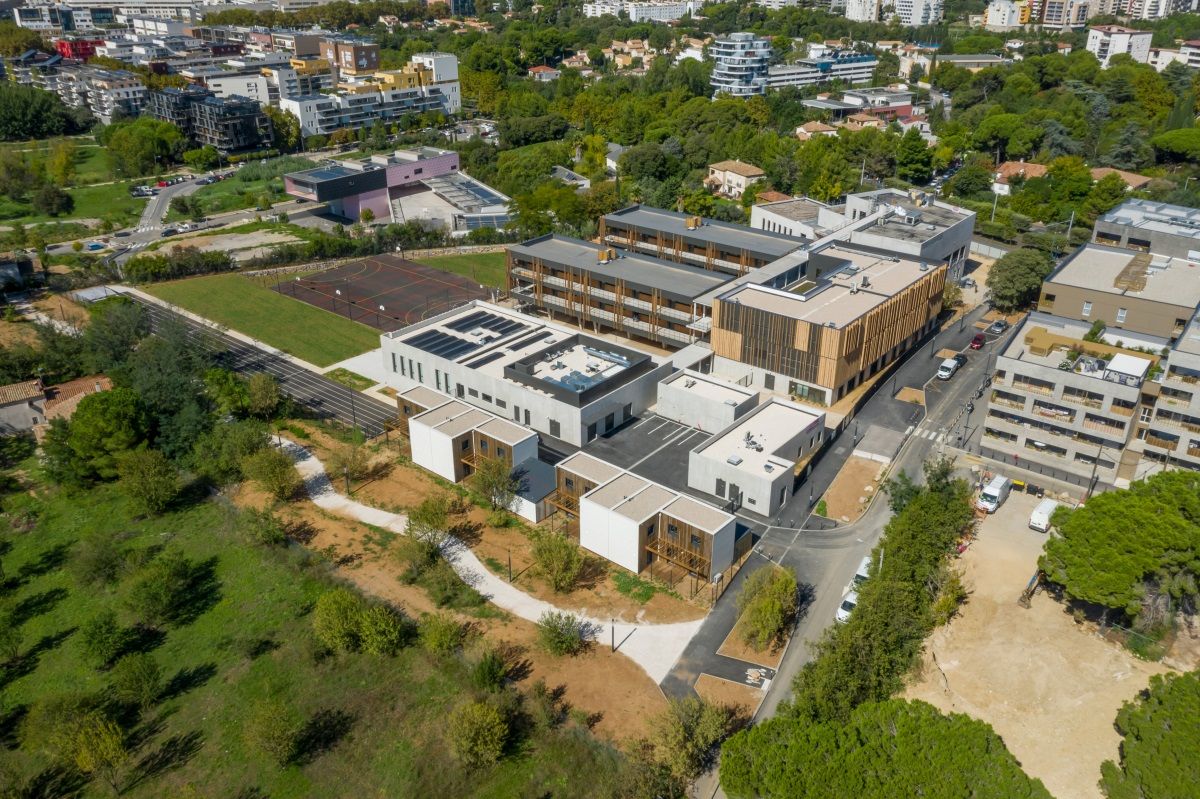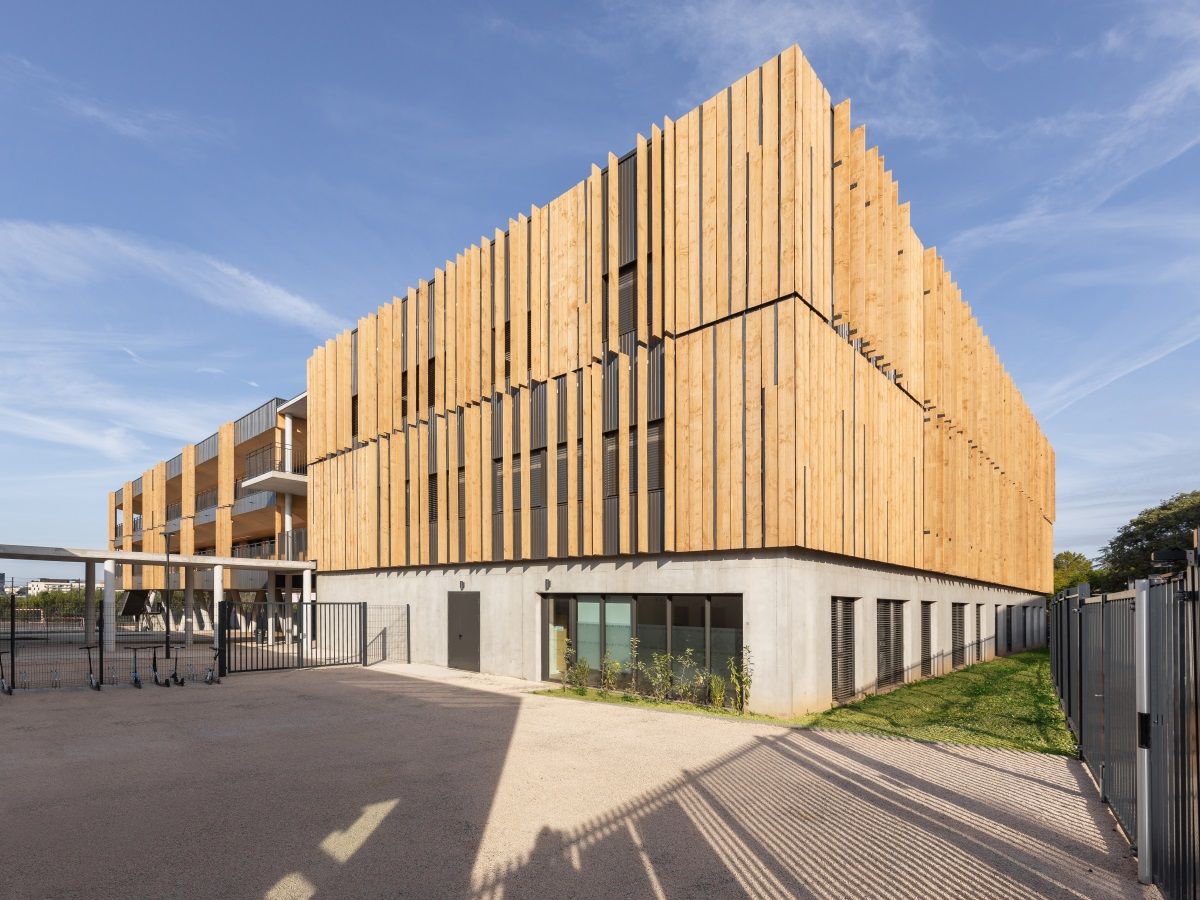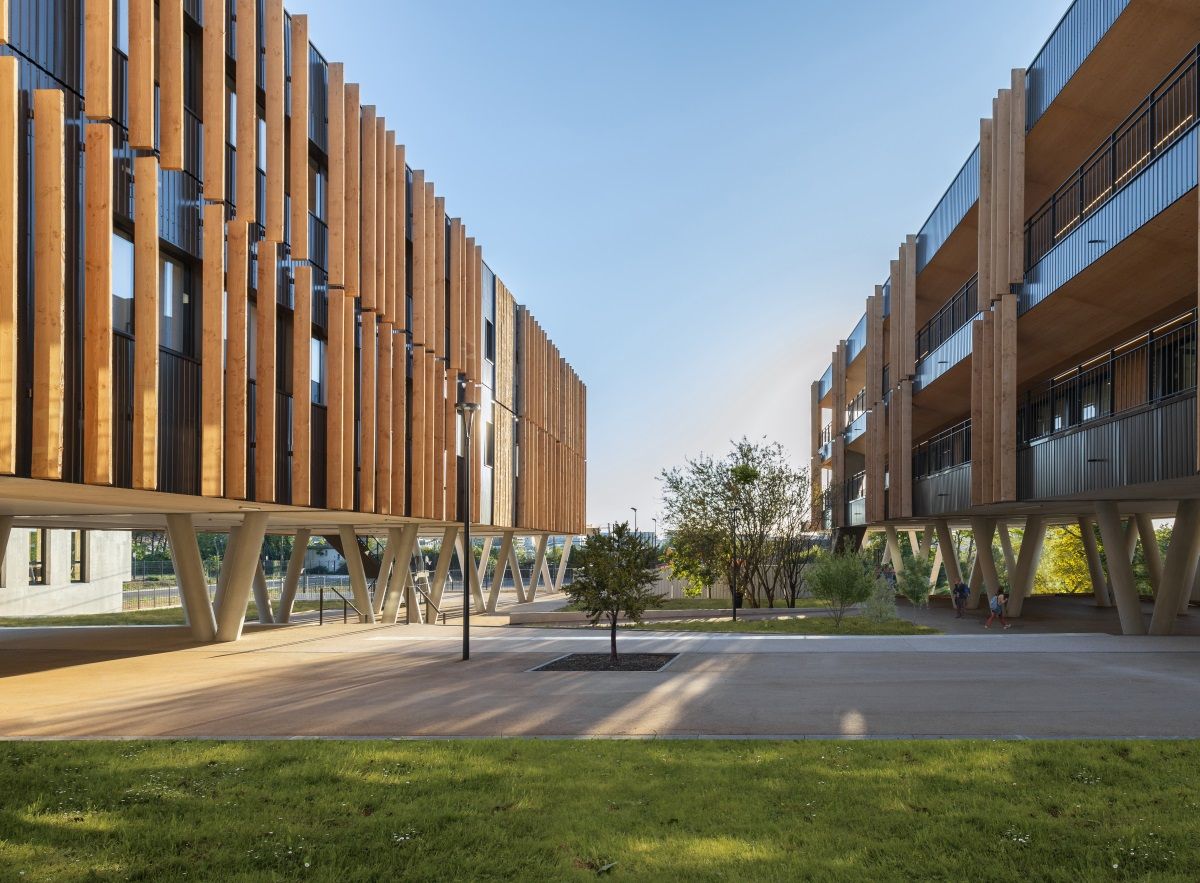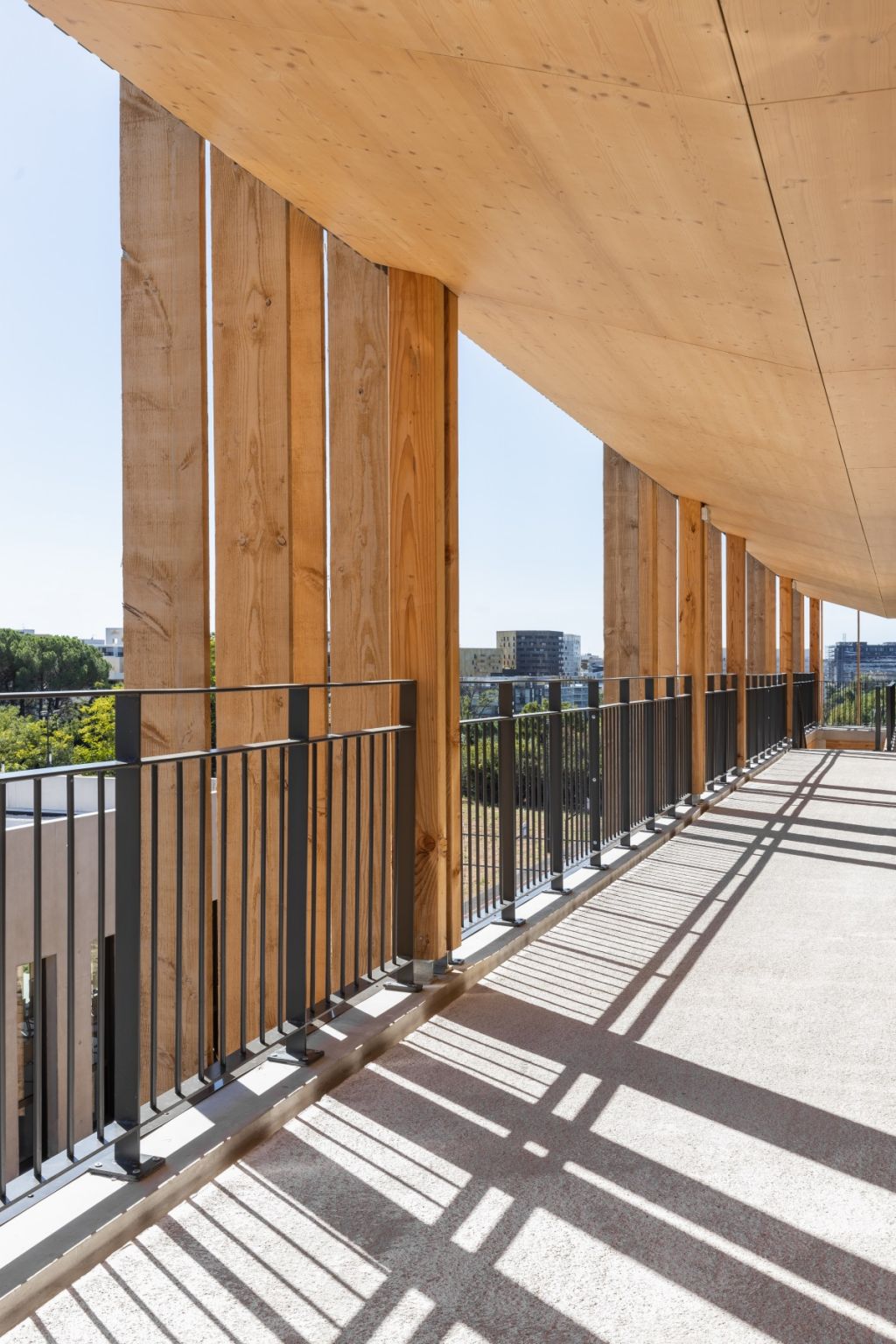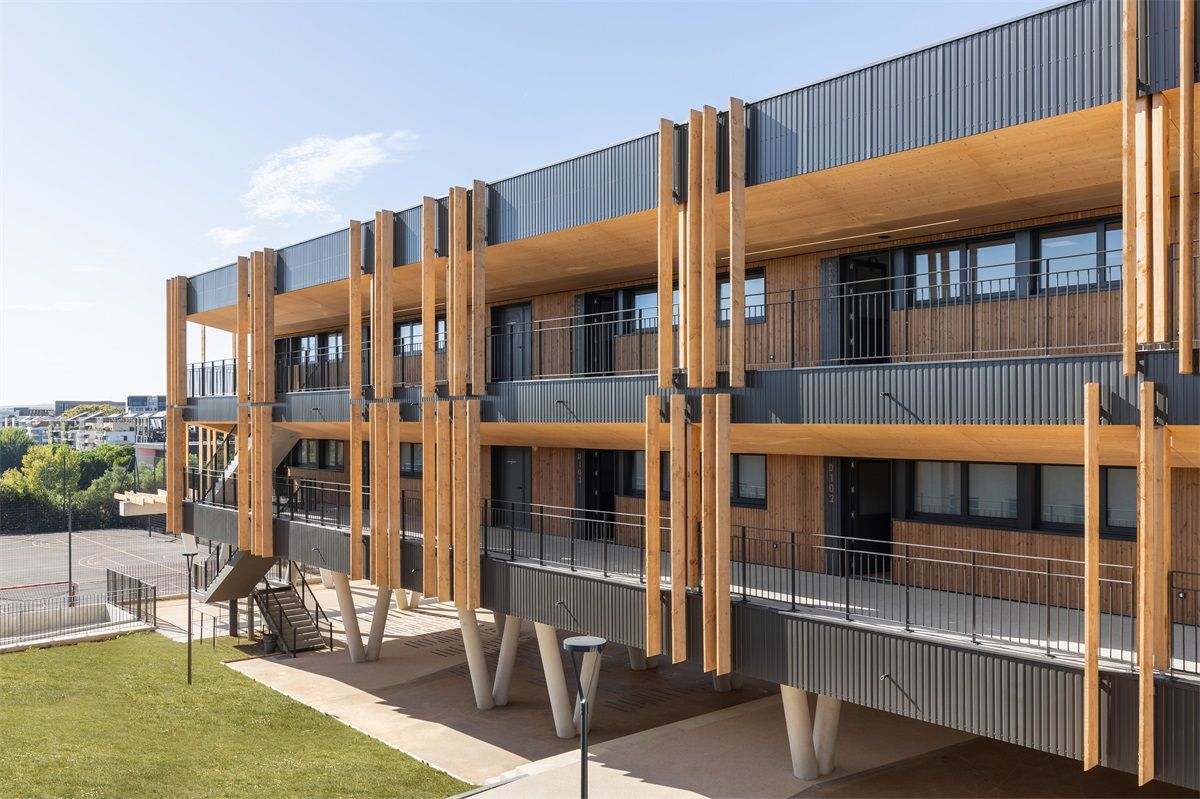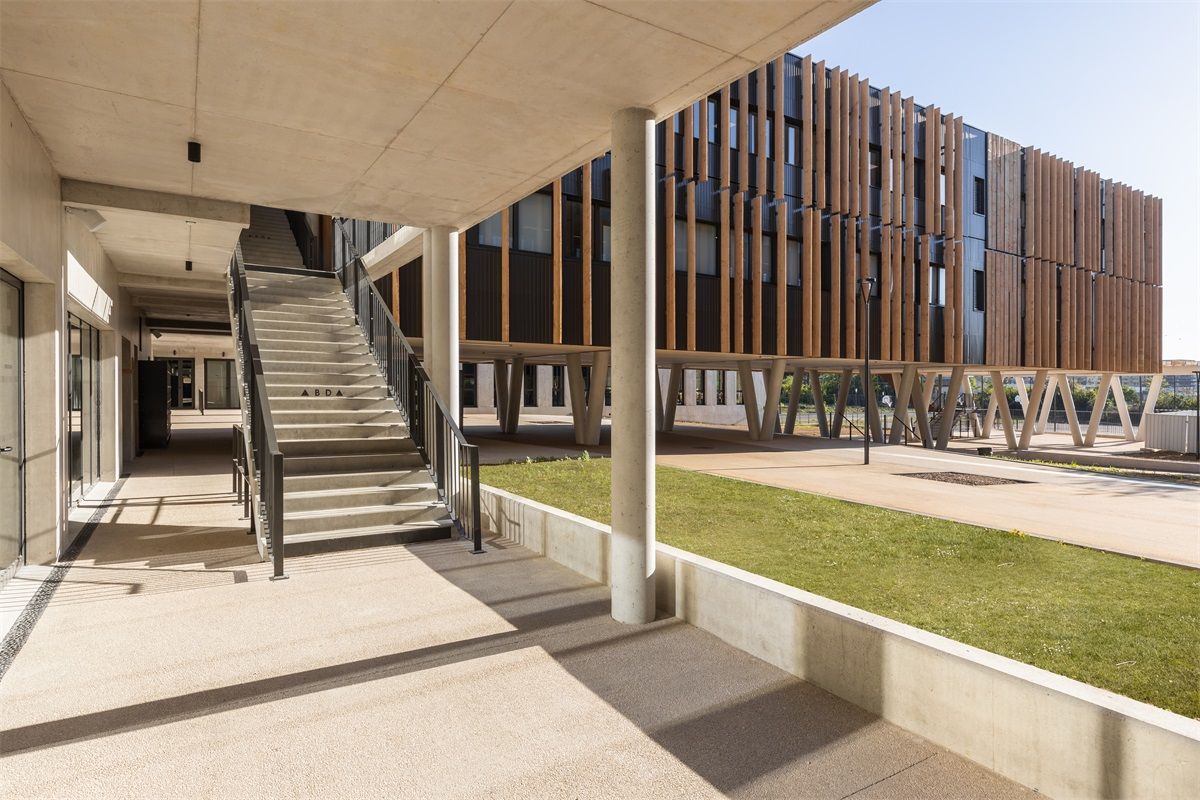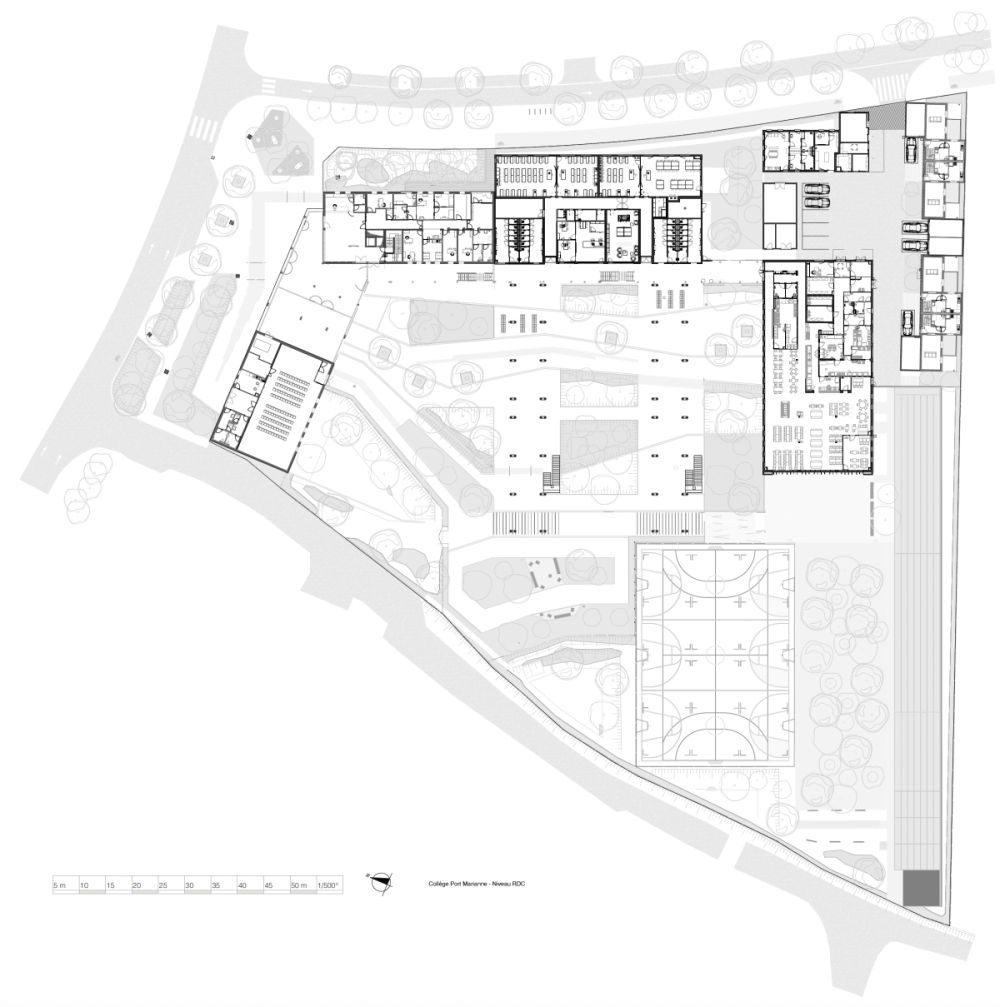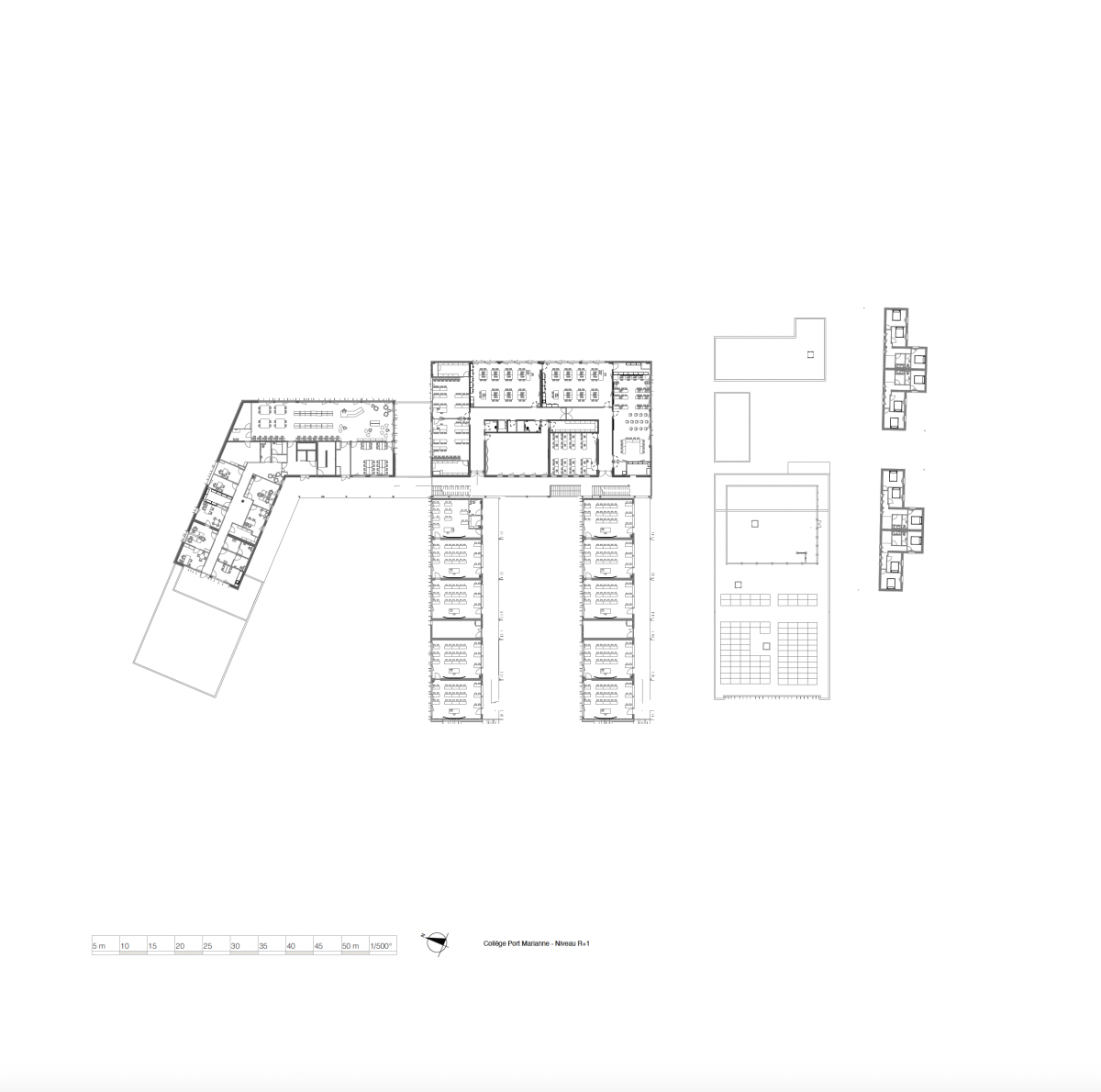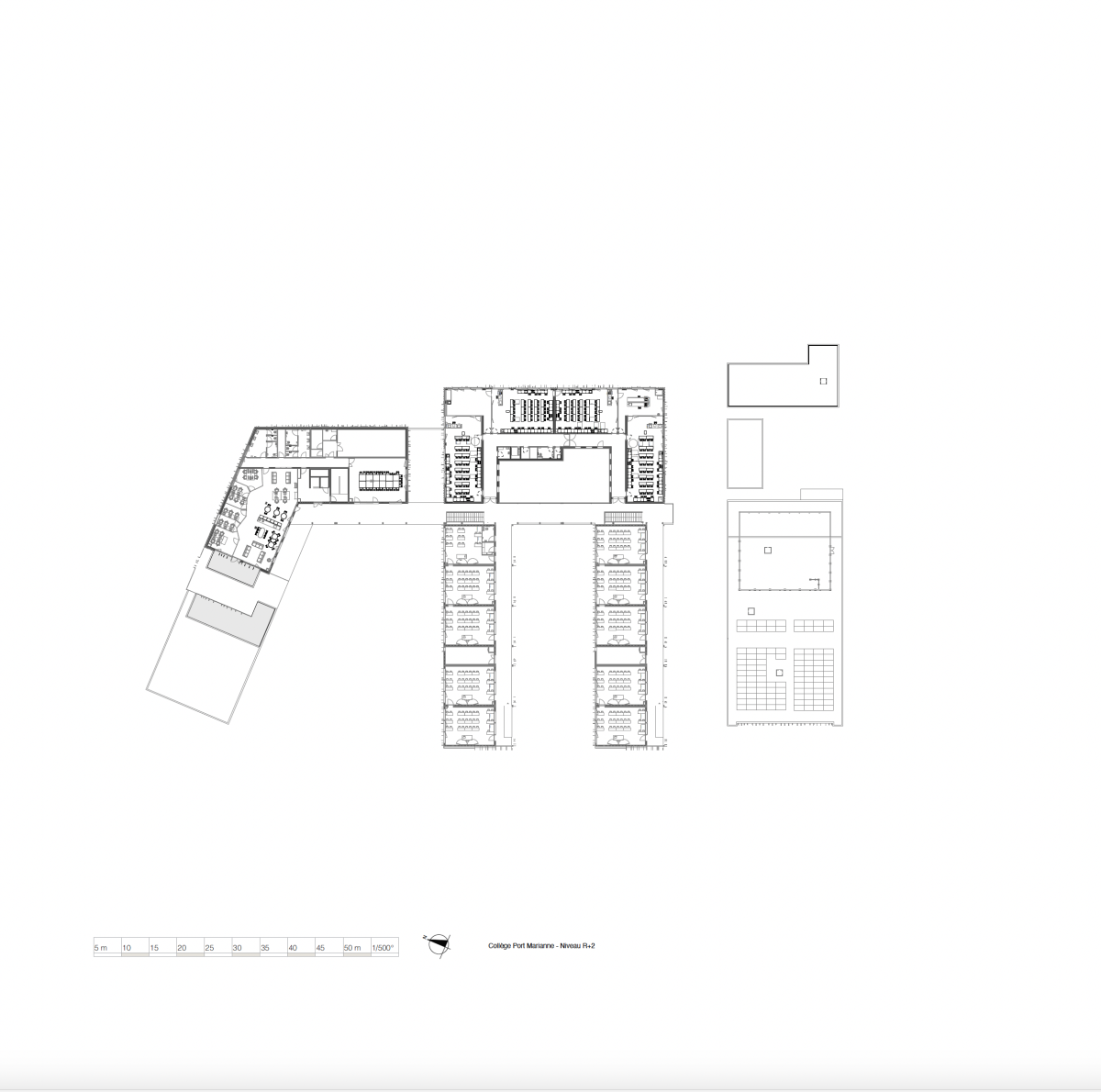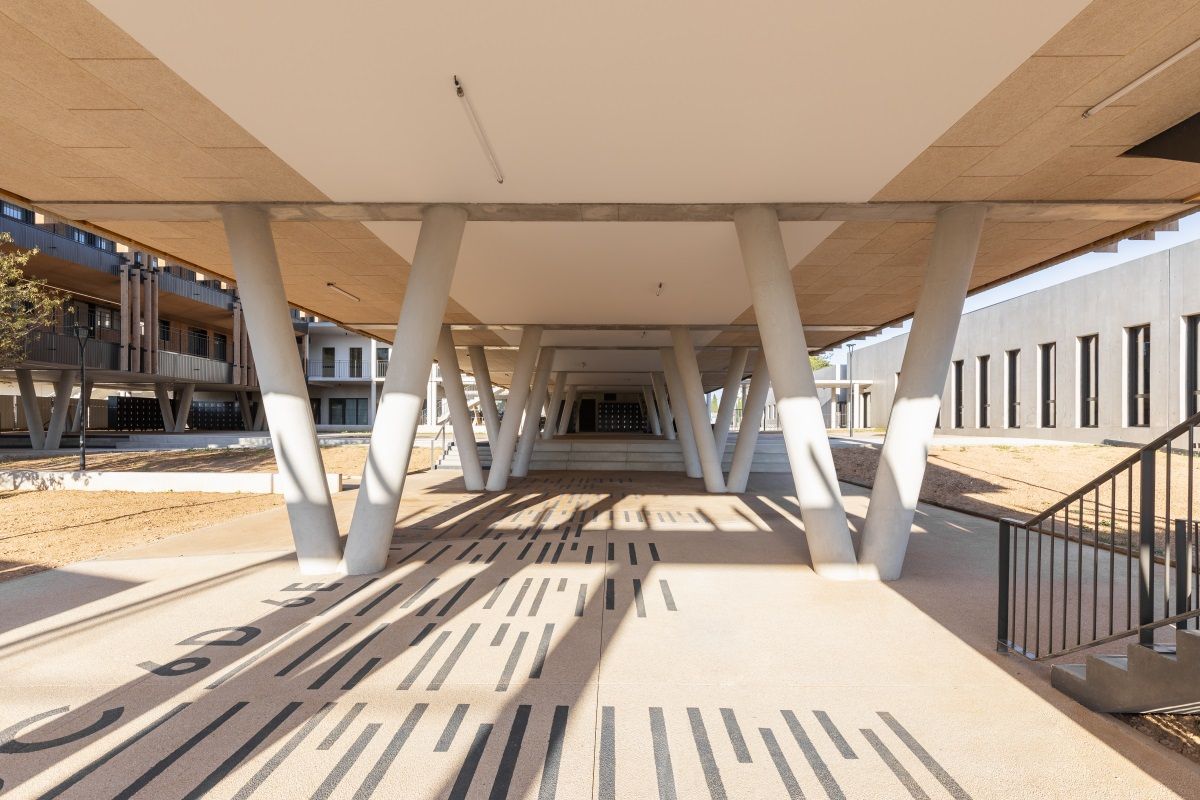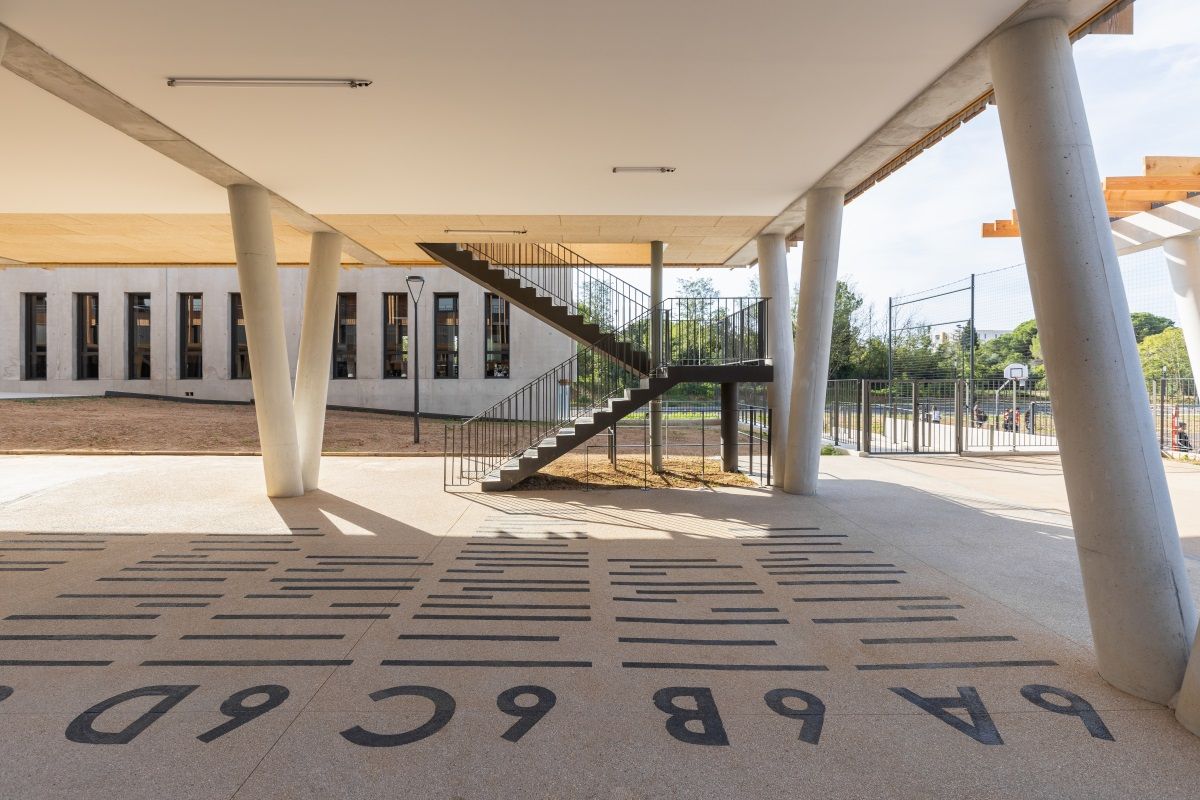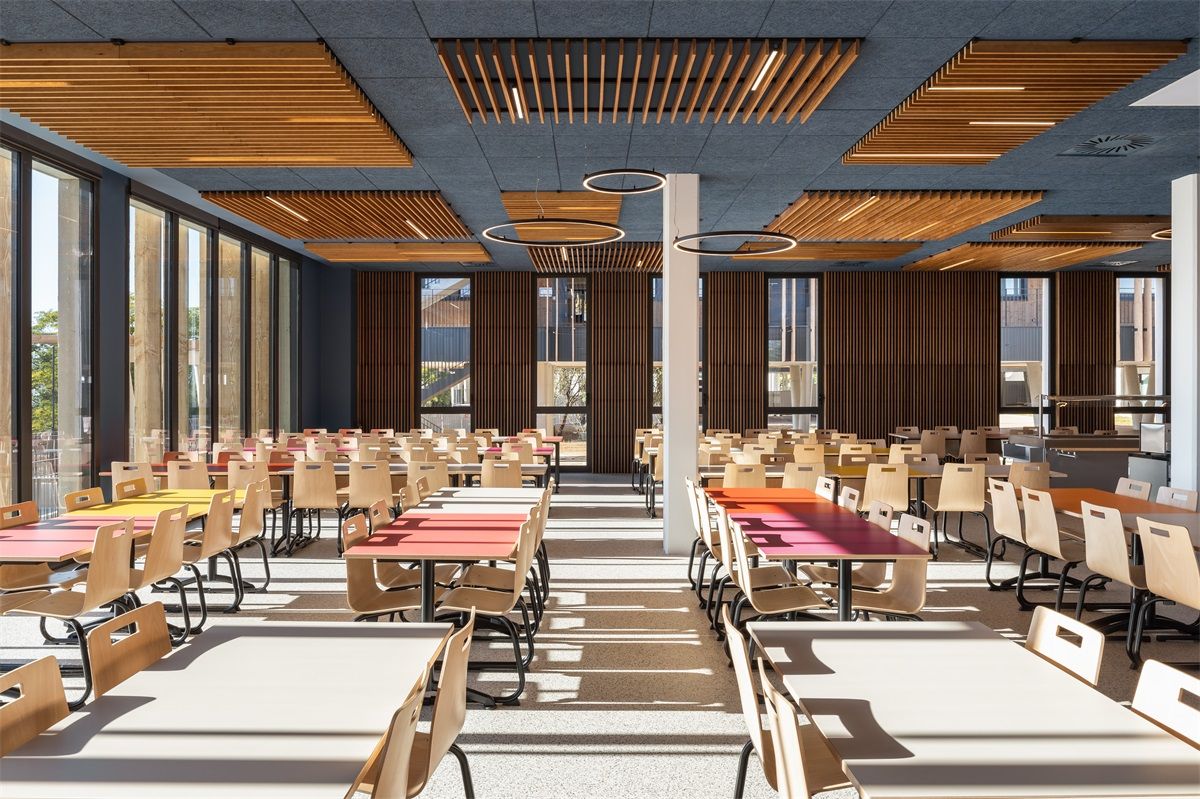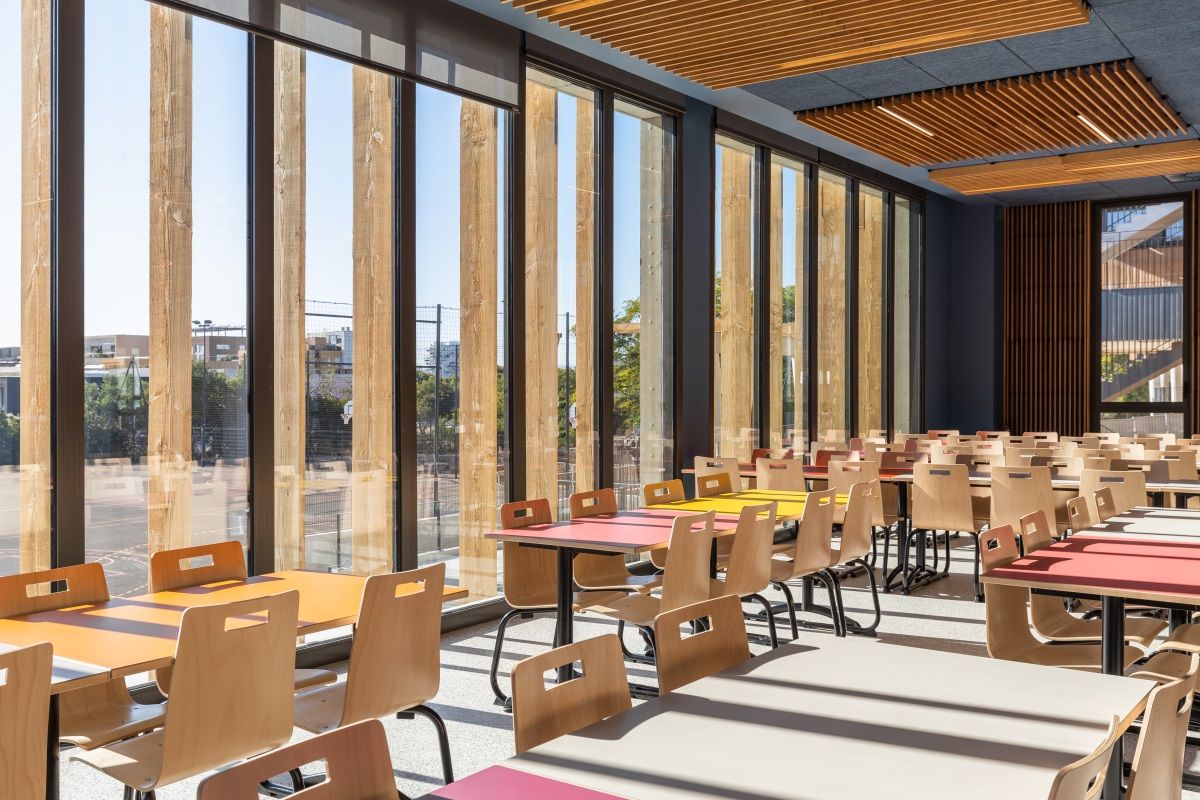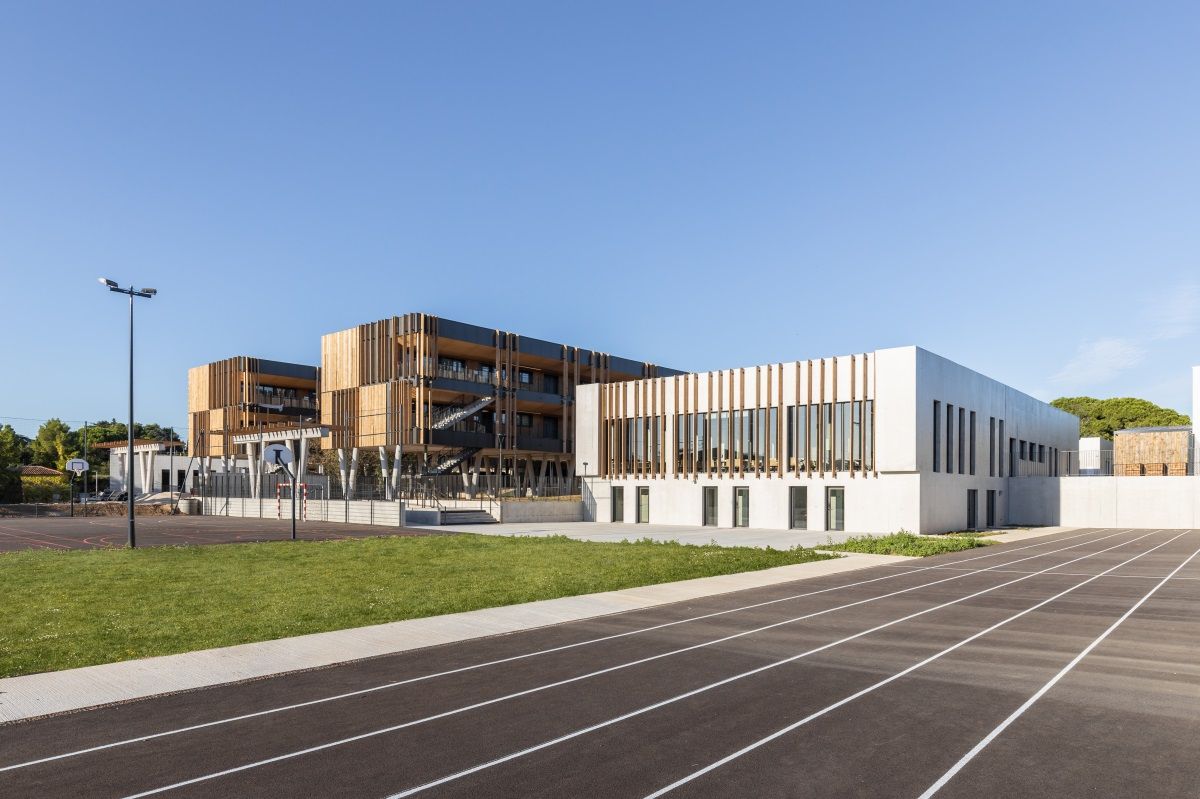|
PORT MARIANNE SECONDARY SCHOOL
Awarded Occitanie sustainable building label, Port Marianne secondary school embodies the challenges of our time. At the heart of a district undergoing an urban reconfiguration, the site has become an exemplary, virtuous and evolving environmental marker, responding to the present and future needs of all users.
The modular part of the general teaching building is built on a high base made of low-carbon concrete and is made of wood for the frame and facing, and of biosourced insulation.
Douglas fir, a local wood from the Gard region, is used on the majority of the façades, while the timber-framed walls and the staff accommodation, made of modular wood, are made of spruce from the Cévennes.
The architectural composition is organised in rigorous and harmonious layers. Large vertical wooden brise-soleils blur the perception and give a homogeneous reading of the whole project. In the classrooms, interconnected with double orientation, natural ventilation is created while natural light circulates everywhere. On the courtyard side, the wooden modules rise up like houses on stilts. The remarkable trees, preserved to favour shade and coolness in summer, as well as the vegetation, contribute to creating a temperate zone.
Through the use of sustainable materials and construction systems, Collège Port Marianne has become an exemplary environmental marker for the Department.
+ BDO Silver Level Label + E3C1 energy commitment + Wooden project + Low-carbon concrete + Biosourced insulation + BIM Level 2
THE PROJECT
Located between Parc Marianne, Odysseum and Parc Charpak, the project is being developed in the heart of an urban environment in the process of being developed, including large planted areas, some of which are remarkable and should be preserved.
To the north, Avenue du Mondial 98, accessible by tramway, serves the main entrance of the school, marked by a generous landscaped square. To the east, the forecourt extends along the whole of Rue de la Cavalade, ensuring urban continuity with the existing buildings and a better connection with Avenue Nina Simone. To the west, Rue du Mas Rouge links the district to Parc Charpak, via a more intimate road, while to the south, a soft leafy connecting path also leads to the Park.
Because of its central geographical location and the strategic issues at stake, the project had to meet several objectives by designing a school that was:
• Urban connecting the city centre to Odysseum by taking an important position on this axis.
• Integrated in its surroundings, with contemporary architecture highlighting the school within the city, as well as the promotion of natural spaces. The project offers breathing space and transparency towards Parc Charpak, and beyond, like a belvedere, towards the landscape axis of Port Marianne and the Jacques Cœur basin.
• Remarkable due to its surface area of green spaces open to users and in the eyes of local residents.
The project gives pride of place to vegetation with the creation of an educational garden, the planting of 114 trees, tiered planted areas and the presence of large courtyards to accommodate all the pupils in hot periods and during rainy episodes.
• Evolving through the choice of a modular wood construction system, allowing spaces to be enlarged, rearranged or, on the contrary, dismantled and easily transferred to another site if necessary.
• Ethical through the use of local sustainable materials.
The school has been awarded the Occitanie Sustainable Building Silver and E3C1 labels and is an exemplary environmental building, in particular through the choice of a low-carbon concrete construction system for the base, the extensive use of wood from the Cévennes and Gard regions in the frame and facing of the buildings, and the use of biosourced insulation.
In terms of energy, the school will achieve an ambitious renewable energy rate of 48%.
The bioclimatic approach also includes a real commitment to winter and summer comfort for users. Instead of excessive recourse to air conditioning, passive solutions are favoured. The classrooms, which are interconnected with double orientation, are equipped with appropriate solar protection and an adiabatic air cooling system.
• Innovative. In addition to the inherent functionality of the school, designed in BIM Level 2, aiming at optimal fluidity and clear legibility for the benefit of students, teachers and administrative staff, the school stands out through its innovative spaces designed to meet new needs: larger unmarked rooms (from 55 to 60 m²) and an active classroom to develop interactive language teaching.
The teachers’ lounge has also been redesigned to provide greater comfort and flexibility through the flex-office model, integrating in the same place relaxation areas, rest areas, quiet pods, shared work spaces and individual work spaces.
Another major issue, the co-education and harassment aspect of the school was the subject of a targeted scheduling choice, with an approach based on the division of the premises (courtyard, lockers, toilets, unmarked classrooms) according to two age groups (6e/5e [11-13 year olds] and 4e/3e [13-15 year olds]) aimed at calming the atmosphere for the pupils. The common room, as an extension of the courtyard, and the large openings in the toilets also allow for fluid exchanges and facilitate use.
SPATIAL ORGANISATION
Four volumetric sequences, separated by a transparency towards the landscaped areas and linked by a common base, make up the project :
• The three-storey building overlooking Avenue du Mondial 98, the main entrance to the school, houses the reception area, the Senghor space, the medical and social care unit, offices, the learning resource centre, the staffroom and the multi-purpose room,
• The three-storey teaching building, which forms a “U” with two separate units, houses the classrooms, with 11-13 year olds pupils on one side, and 13-15 year olds pupils on the other,
• A catering and logistics centre on the upper ground floor,
• Two-storey staff accommodation.
GROUND FLOOR PLAN
FIRST FLOOR
SECOND FLOOR
CONSTRUCTION SYSTEM
Structure
Mixed wood and concrete: concrete slabs and post-and-beam, unmarked classrooms and staff accommodation in wooden modules, wooden frame façades and wooden facing
Framework and roofing
Roof terrace: concrete slab with polyurethane (20 cm) insulation under vegetation (R = 9 m².K/W)
Wooden frame roof: mineral wool insulation (40 cm) (R = 10 m².K/W)
Outer walls
Specialised teaching rooms: wooden frame with wood fibre (20 cm) insulation (R = 5.37 m².K/W)
Unmarked teaching rooms: wooden frame with wood fibre (14 cm) and recycled textile insulation (R = 4.95 m².K/W)
Ground floor and passageways: concrete with mineral wool insulation (16 cm) (R = 5 m².K/W)
Façade linings: metal cladding, wooden cladding or rough concrete depending on exposure/floors
Low floor
Over covered courtyard: cellulose wadding (22 cm) insulation (R = 5.5 m².K/W)
Over earth platform: concrete with extruded polystyrene (16 cm) insulation on the underside (R = 4.9 m².K/W)
Over car park: concrete with sprayed insulation on the underside (20 cm) (R = 4.9 m².K/W)
Joinery
Window frame: aluminium
Glazing: double glazing (Uw = 1.4 W/m².K and Sw = 0.3 - 0.51)
Shutters: fixed vertical sheets, roller blinds, orientable brise-soleils, inner thermal sun-blinds
EQUIPMENT
Heating
Production: District heating from the city of Montpellier, P = 402 kW
Emission
Offices: radiators
Classrooms, learning resource centre, multi-purpose room, etc.: hot fan batteries
Hot Water
Electric water heaters (30L or 50L)
Ventilation
10 dual-flow air handling units
Cooling
Production: cooling unit, P = 168 kW, EER = 3.98
Emission: cool fan batteries
Lighting
LED, automatic dimming and
presence detection
Energy production
Photovoltaic self-consumption as a priority
P = 40 kWc
ENERGY CONSUMPTION
Regulatory primary energy consumption target: 49 kWhPE/m².year
ENERGY YIELD
Photovoltaic yield target: 50 MWh/year
DELIVERY
Partial delivery August 2022 / end March 2023
2021 competition winner
LOCATION
Montpellier (Hérault)
PROJECT OWNER
Hérault Departmental Council
ASSISTANT PROJECT OWNER
EGE Ingénierie
AREA
6,575 m2 net floor area
TASK
Complete project management + EXE + SYN + BIM + Commissioning
COST OF THE WORKS
€18,000,000 (excl. tax)
PROGRAMME
Construction, operation and maintenance of a wooden secondary school for 750 students (extendable up to 900) located in the Port Marianne district, including a medical and social care unit, offices, the learning resource centre, the teaching area, a multi-purpose room, a catering/logistics centre, accommodation on the first floor and a sports complex.
PROJECT MANAGEMENT TEAM
Agent
Bouygues Bâtiment Centre Sud-Est
Architects
A+Architecture and AMG Architectes
Wooden structure consulting engineers
Arborescence
Concrete structure consulting engineers
Sodeba
Acoustic consulting engineers
Atelier Rouch
Kitchen consulting engineers
AC2R
Technical college consulting engineers
BET Durand
Environmental consulting engineers
Inddigo
Roads & External Works consulting engineers
Seri
Landscaper
Eskis Paysagistes
CONTRACTOR
3D modular wood contractors
Selvea (teaching rooms) and T-H (accommodation)
Brise-soleil and slatted wood facing contractor
Environnement Bois
Wooden frame façades and wooden frame houses
Arbosphère
Operation and maintenance contractor
Climater
|


